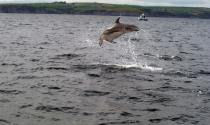Dolphin Research |
Dolphin research has centred largely on the Bottlenose Dolphin with regard to dolphin cognition, communication, calf development, most appropriate methods of conservation and dolphin-assisted therapy. Communication in Bottlenose Dolphins appears to be extensive and complex. Scientists at the dolphin research centre believe that as a group of dolphins finds a school of prey fish they will increase their vocalisations to attract more dolphins to the area. This, they believe, achieves a two-fold benefit. Firstly, more animals increase the chances of rounding up the prey species efficiently. Secondly, increased numbers confers safety on the group should other large predators want to feed from the same prey source or on members of the group. Although conclusions drawn from dolphin research on captive animals have to be treated with caution there are a number of instances where studies on captive animals, under strictly controlled conditions, can yield valuable information on the physiology of diving, social behaviour and sleep requirements and patterns. Participants in the long term Sarasota Bay study of Bottlenose Dolphins have identified four types of social unit. A mother-calf pair, groups of sub adults of either sex, adult females with their calves and adult, sexually mature males. In this society, dubbed the fission-fusion society, there is considerable movement of individual animals and the way they interact is determined largely by the breeding biology of the different units.
Study of DolphinsThe study of dolphins across several countries has suggested that the healing process in humans may be enhanced through contact with dolphins. There are many who are sceptical about this approach as it is very difficult to demonstrate the scientific basis of such claims. However, there are a number of cases of both children and adults where cases of depression, anxiety and learning difficulties appear to have been alleviated following contact with dolphins…especially the Bottlenose Dolphin. Some doctors and biologists are looking carefully at these claims. However, Whale Watch West Cork has examined the evidence very carefully and finds little evidence in support of the fact that physical contact with dolphins, although a pleasurable and meaningful experience is unlikely to have any impact on neurologically damaged or impaired individuals. Claims to the contrary, in our opinion, have no basis in science and perhaps have more to do with making money. Additionally, the requirement for dolphins to be held in captivity to provide these facilities as well as the lack of evidence supporting the benefits of contact suggest, in our opinion, that there is no good reason for continuing the practice. The discussion of this aspect of dolphin research on this website does not imply our support for it. More recently the study of dolphins has concentrated on the behavioural aspects of animals in the wild but many species inhabit waters well off the continental shelf region making location and long-term study very difficult. This is compounded by the fact that these animals may spend upward of 80% of their time under the water and show very little of their bodies when they surface to breath. Several studies have been conducted on those groups of Bottlenose Dolphins that live in a defined geographical area such as the Shannon Estuary in Ireland, Sarasota Bay in California and the Moray Firth in Scotland.Origin of DolphinsIt is generally believed that all marine mammals evolved from land based ancestors around 50-60 million years ago. Of all the marine mammals the dolphins are among those most adapted to an aquatic way of life. All cetaceans were well diversified around 50 million years ago. It is widely accepted in scientific circles that both the baleen and toothed whales shared a common ancestor, now extinct. The closest living relatives of dolphins today are the even toed ungulates such as camels and cows with the humble hippopotamus being the closest living relative. The origin of dolphins and the origin of whales in general is the subject of much debate. Did they evolve from an ancient ungulate order or did they diverge along with the hippopotamus from another lesser known group of animals land based ungulates?
Read more about:
Return to TopOur Dolphin & Whale Watching Tours
|
Click on images for larger view:
|
Whale WatchingWhale Watching in IrelandWhale Watching TripsWhale Watching HolidaysDolphin WatchingDolphin EncountersDolphin HolidaysOther Marine Wildlife Tours |
More About WhalesWhale ConservationWhale PicturesMore About DolphinsDolphin PicturesPorpoisesSealsAbout
|
A Note from one of our visitors...
Hi Nic,Thanks for the newsletter, great read! I have become very enthusiastic about Cetacens over the past six months in no small way due to your great trips.
The fin whale's last weekend were superb, from a sheer size prospective.
Having read about them though I can't wait to see my first humpback. Hope to get out with you in the next few weeks again or over the christmas break. If you have anything planned let me know by email.
Thanks again.
Dan Lettice














